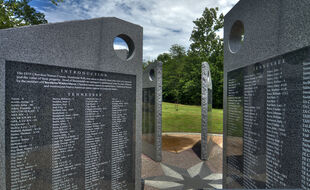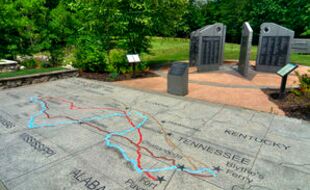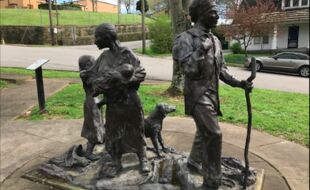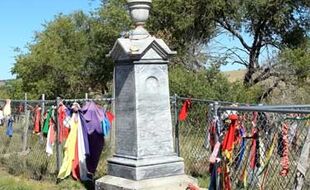Recognizing Injustices in American History Through Memorials
Introduction
According to the Los Angeles Times and NPR, American Indians are the single most oppressed and discriminated race in the United States. The history of Indigenous peoples is largely defined by the fierce, greedy practices of white colonists—namely, forcing unfair legal agreements on tribes, murdering peaceful Indigenous communities to maintain control of resources, and subjecting Indigenous families to torturous migration. The U.S. government usurped 67% of land owned by Indigenous peoples and relegated the entire race to that of “uncivilized” which has permanently scarred American Indian culture. The lasting effects of colonialism is reflected by the prevalence of social and economic discrimination that Indigenous peoples currently face. A study conducted by the Harvard T.H. Chan School of Public Health found that 75% of Native Americans believe that Native people are discriminated against in America today. However, the First Nations Development Institute found that only 34% of American believe that Native people still face discrimination. Both of these statistics include discrimination by individual people, laws and government policies. There is a stark contrast between these competing perceptions, and memorials commemorating Indigenous peoples have helped to close this gap by communicating racial issues in an empathetic and comprehensive way. Each memorial that I will discuss utilizes tools of visual rhetoric to give a deeper meaning to the numbers that define the injustices faced by Indigenous communities. These efforts aim to “bring back the bodies” through techniques outlined by D’Ignazio and Klien in The Numbers Don’t Speak for Themselves. In this digital exhibit, I will argue that memorials recognize the injustices led by Americans and the U.S. government on Indigenous peoples by utilizing tools of visual rhetoric to humanize this history of malpractice.
Trail of Tears Cherokee Removal Park
The Trail of Tears describes the period from 1830 to 1850 where approximately 60,000 Indigenous peoples were removed from their homes in Alabama, Arkansas, North Carolina, Georgia, Illinois, Kentucky, Missouri, Oklahoma and Tennessee through a conjoined effort by state governments and forced to walk more than 1,200 miles to Indian territory. Starvation and disease were rampant during the forced migration, and historians estimate that more than 5,000 Cherokees died along the journey. The Trail of Tears is one of many instances where Indigenous peoples were discriminated against and unjustly treated due to White Americans fearing and resenting Indigenous people and culture, as well as desiring the abundant resources present throughout their territory.
The Trails of Tears Cherokee Removal Park has two major components to commemorate this event. Firstly, there are four granite walls engraved with the names of each documented Cherokee who died during the Trail of Tears. Rather than listing the number of Cherokee deaths as a result of American greed and discrimination, paying tribute to each individual by listing the thousand of names more meaningfully communicates how cruel and neglectful the government was to Indigenous populations, and demonstrates that the human pain and suffering was a reality for thousands. Secondly, there is a map that outlines the trail that Cherokees from different states were forced along to reach the Indian territory. By visualizing the distance walked rather than listing the number of miles or state crossed, the map communicates the physical and mental exhaustion that Cherokee men, women, and children were subjected to for months. Both components serve to humanize the Trail of Tears and educate the readers by relating the pain of Cherokees in a more understandable context. These visual techniques give greater emotional significance to the sometimes stale numbers written by historians, which lack the same strong sense of horror and injustice.
Pulaski / Giles County Trail of Tears
The Pulaski/Giles County Trail of Tears Interpretive Center also commemorates the Cherokees who were forcibly relocated during the Trail of Tears period, but uses alternative visual rhetoric techniques to communicate a similar message of suffering due to unjust treatment by the government. One of the central monuments is “The Trail Where They Cried” which is a bronze statue depicting a Cherokee family—a father, a mother holding a newborn child, their young daughter, and their dog—walking the Trail of Tears. A representative whom I’ve spoken with from the interpretive center identified that the significance of the monument lies within the concerning difference in facial/body expressions between the parents and their daughter. The parents are visibly concerned and confused; they are cognizant of challenges that lie before them and are unequipped to ensure the safety of themselves and their children. In contrast, the young girl appears to have a playful demeanor and not nearly as anxious as her parents, which is largely due to her being unaware of the impending suffering. The keystone quote associated with the monument is from the young girl and translates to “Why can’t we go back home?”
This juxtaposition of these expressions plays on the viewer’s emotions and digs deeper into the uncertain, morbid future that many Indigenous peoples faced as a result of the injustices led by the U.S. government. This monument moves past the numbers and relates to how the families that suffered along the trail are the same as our own concepts of family—they have loving parents who strive to protect their children from fear and danger. In this case, the family was at the mercy of the greed of Americans. This monument furthers the mission to realize the truth behind the treatment of Indigenous peoples by humanizing the victims in an empathetic way.
Wounded Knee Memorial
The Wounded Knee Memorial serves as a mass grave for the 98 men, 65 women, and 24 children who were shot and killed as the 7th Calvary (470 soldiers) during the Wounded Knee Massacre (1890). To give context, the Lakota people—a subgroup of the Sioux Indians—became increasingly resistant and violent towards White Americans as the Lakota experienced a history of White settlers attempting to claim Indian territory, the U.S. government continuously broke legal agreements and usurped land/resources, and White Americans forced Lakota people to “become civilized” by adopting certain lifestyles and religion. The Ghost Dance religious movement was a type of peaceful religious circle dance to address the intense violence led by White settlers. During the 7th Calvary’s attempt to surrender Lakota people on December 28th, 1890, the Lakota people responded with the Ghost Dance rather than surrendering weapons. A shot was accidentally fired by a Lakota person, causing the situation to turn violent and the Calvary responded by open firing on the community.
The single marker is a mass grave for all 187 Lakota people who died during this massacre. The significance of the memorial, however, is not just attributed to the marker, but also largely to the effort by the local community to maintain elements around the marker. Small gifts are left at the base of the monument, twigs of sage are placed around the grave, and pieces of cloth are tied to the gate surrounding the marker which serve as prayers to those impacted by the massacre. The ongoing efforts to commemorate those who have died demonstrate that the pain from the injustices experienced by Indigenous peoples is timeless. Families renew the tributes placed around the marker every day, which empathetically communicates how Indigenous communities still suffer from such merciless practices of the past. The power of this memorial lies within these tributes and conveys how these victims were real people who are loved, and not simply just an obstacle by White Americans or another number listed by historians
Works Cited
DISCRIMINATION IN AMERICA: EXPERIENCES AND VIEWS OF NATIVE AMERICANS. Harvard T.H. Chan School of Public Health, Nov. 2017, legacy.npr.org/documents/2017/nov/NPR-discrimination-native-americans-final.pdf.
D'Ignazio, Catherine, and Lauren Klein. “Chapter Five: The Numbers Don't Speak for Themselves · MIT Press Open.” MIT Press Open, PubPub, 5 Nov. 2018, mitpressonpubpub.mitpress.mit.edu/pub/6ui5n4vo/release/4.
History.com Editors. “Trail of Tears.” History.com, A&E Television Networks, 9 Nov. 2009, www.history.com/topics/native-american-history/trail-of-tears.
Hudson, Myles. “Wounded Knee Massacre.” Encyclopædia Britannica, Encyclopædia Britannica, Inc., www.britannica.com/event/Wounded-Knee-Massacre.
Neel, Joe. “Poll: Native Americans See Far More Discrimination In Areas Where They Are A Majority.” NPR, NPR, 14 Nov. 2017, www.npr.org/2017/11/14/563306555/poll-native-americans-see-far-more-disc....
“Pulaski / Giles County Trail of Tears Memorial.” NATIVE HISTORY ASSOCIATION - Pulaski/Giles County Trail of Tears Memorial, 2012, www.nativehistoryassociation.org/giles_tot_memorial.php.
“Research Reveals America's Attitudes about Native People and Native Issues.” Cultural Survival, 27 June 2018, www.culturalsurvival.org/news/research-reveals-americas-attitudes-about-....
Usa, Wfwp. “WHY THE TRAIL OF TEARS? PEACEMAKERS FOR SACRED HEALING PRAYER JOURNEY.” Women's Federation for World Peace USA, Women's Federation for World Peace USA, 6 Oct. 2013, www.wfwp.us/news-articles/national/why-the-trail-of-tears-peacemakers-fo....








